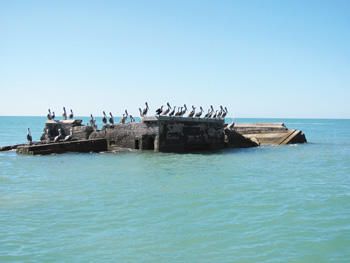Book explores Egmont Key

Part of Fort Dade, once on Egmont Key, has been
claimed by the Gulf of Mexico.
EGMONT KEY – Look north from any place on the Gulf beaches of Anna Maria Island.
There, see it?
Keep watching.
Keep watching.
See it?
It’s the Egmont Key lighthouse, still working after 154 years.
The lighthouse and the rest of the rich history of Egmont Key is the focus of a new book by retired teachers Donald and Carol Thompson, of the Egmont Key Alliance.
The book is available just in time to bone up on Egmont Key history before Discover the Island Days the weekend of Nov. 10-11, a fundraiser for the alliance, which aims to protect, restore and preserve the island.
Early Spanish navigational charts named the island at the mouth of Bahia Espiritu Santo (Holy Ghost Bay) Isla de Cruz for the large cross planted there by Spanish surveyor Francisco Maria Celi in 1757, according to the Thompsons. The island was re-named Egmont Key in 1763 by the British in honor of the First Lord of the Admiralty and Second Lord of Egmont, Sir John Perceval.
The book ties together some loose ends about Egmont Key history. In the 1830s, Seminole Indians, including Chief Billy Bowlegs, were imprisoned on Egmont Key during their forced removal to Oklahoma reservations. Later, in 1835, Seminoles killed Major Francis Dade and 108 soldiers near Bushnell, Fla.; Fort Dade on Egmont Key was named for Dade more than 60 years later. Florida railroad builder Henry Plant had lobbied Congress to build the fort, echoing the suggestion of Robert E. Lee before he led Confederate forces in the War Between the States.
The book also substantiates legends about the island, like the fact that construction on the lighthouse had to be suspended in 1847 because the supply ship carrying the bricks ran aground – for lack of a lighthouse.
The island was held first by Confederate and then by Union forces during the Civil War, but the rebels hid the lighthouse lens so the Union forces couldn’t find Southern blockade runners approaching the coast, according to the book; the Union instead used the lighthouse as a watchtower.
The book corrects some misconceptions, like the history of the U.S.S. Narcissus. A Union ship, it lies submerged just off Egmont Key’s northeast shoreline, but the South didn’t sink it there. A Confederate torpedo sank it off Mobile, Ala., but it was reconstructed and used as a dispatch boat, later sinking off Egmont Key in a storm in 1866.
The Thompsons bring to life major disasters like the hurricane of 1921, which put Egmont Key underwater, forcing 75 people up the lighthouse until the water receded.
The book also details the ecology of Egmont Key, from a humpback whale spotted off the coast in 1962 to its present day gopher tortoise population and sea turtle and bird nesting grounds.
Other chapters include the family history of a lighthouse keeper, and the history of the Tampa Bay Pilots, based on the island, who travel out to sea to meet ships, board them on rope ladders and guide them into local ports.
The Thompsons also look to the future of the island, urging action to save the remains of Fort Dade. Two gun batteries already are underwater, eroded by the elements, with beach renourishment tentatively scheduled for 2013.
The book is available at local bookstores and from the publisher at www.historypress.net or call 866-457-5971.
For more information about Discover the Island, visit www.EgmontKey.info or call 727-813-2627.

